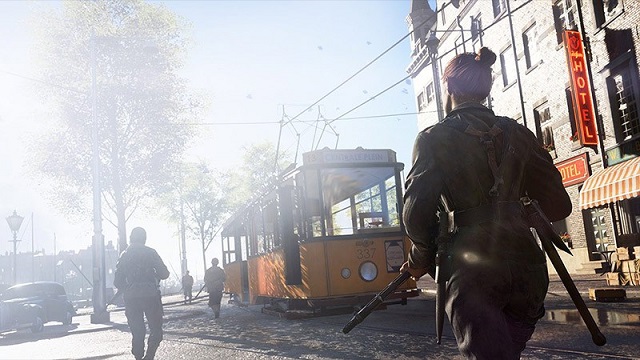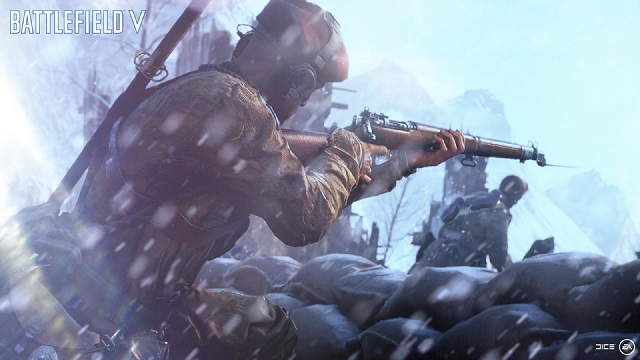If you’re keyed into tech or just like visceral first-person shooters, there’s little doubt you’ve already seen the eye-popping Battlefield 5 trailer that came out of Gamescom back in August. Chances are, you’ve also seen the 15-minutes of alpha gameplay PC Gamer was able to get at PAX West. Both videos show Nvidia’s new RTX graphics cards really are that powerful and that developers like EA are already implementing the tech in their upcoming games to stunning effect.
With the most recent Battlefield 5 beta already in full swing, we won’t be able to get our fix of ray tracing goodness at least until the next beta (if there is one). That’s because Nvidia’s 20 series doesn’t release until September 20 — not to mention it’ll be some time before many of us get our hands on the tech anyway. However, we can use the current beta as another practical litmus test for how powerful the 20 series will actually be.
Regardless of if we have the cards in our slots now or not, Nvidia’s new GPUs will undoubtedly make bellwethers like Battlefield 5 more realistic tent-pole experiences. In a nutshell, the hardware allows for more true-to-life reflections and in-game renderings, providing us gamers with more realized worlds, narratives, and gameplay moments.

The thing about ray tracing is that it has tons of upside, especially if you’re a graphics snob like me. Lighting is more vibrant, shadows are darker, explosions are more electric, and reflections more vivid. A good dose of expert lighting goes a long way in conveying a game’s environment and tone; it can even support other elements such as a game’s story and, especially, its gameplay. The difference between clearly seeing an enemy and not seeing an enemy can quite literally be the difference between night and day, winning and losing.
While we most certainly could, let’s not get into the technobabble that is ray tracing specifics, cube maps, specular reflections, and the like. Instead, let’s focus for a moment on more practical aspects of the technology. Aside from everything mentioned above, a world with ray tracing means a world with entirely new possibilities we don’t fully know we need. Currently, there are aspects of games that go relatively unnoticed or underutilized without ray tracing, especially if you aren’t directly looking at them.
For example, muzzle fire. If it happens to your right or left in an FPS without ray tracing, you rarely, if ever, see the flashes at all. If you do, they’re infinitesimally less brilliant than they could be. With ray tracing, particles of light from those flashes are reflected off other in-game surfaces to give the illusion of peripheral vision, for example. Because reflections off of mirrors, windows, and even rifle scopes will accurately mirror your environment in real-time, you’ll even be able to potentially see enemies sneaking up behind you, helping you keep that K/D pristine or adding to the immersion.

None of this even considers the power Nvidia’s new RTX line brings in terms of pure processing power, using more CUDA cores to generate better overall gameplay at higher settings even if you don’t consider ray tracing.
If you put your eyeballs back in your head and re-watch the footage above, you’ll also notice that Battlefield 5‘s animations are ridiculously crisp and clean. There’s not a single tear or stutter in sight. Of course, you’d expect that out of a trailer being used to showcase brand-new tech, but BF5‘s Pax West gameplay footage backs that up.
Think about how Shadow of the Tomb Raider “ran” at Gamescom for a second. The game looked great in its showcase demo, but in comparison, Battlefield 5 looked (and looks) even better with RTX power behind it. In many ways, EA’s new shooter acts as a superior barometer for what we can expect out of Nvidia’s new RTX line. Shadow of the Tomb Raider had difficulty hitting 60fps even at 1080p while implementing ray tracing tech, according to hands-on previews of the game at Gamescom. There are many reasons why, but one thing is certain:
Of course, it’s still early in the learning cycle for these cards; games like SotTR struggling to hold steady framerates during demos is somewhat expected, especially considering most devs didn’t actually have RTX cards on hand when making the games in question. There are also various optimizations to consider and, on top of that, we have to consider how each game was built — either with or without RTX in mind at all. There’s also the fact that, well, these graphics cards are new.
Invariably, Nvidia will tweak and balance the hardware post-release.
Regardless of all that, we know Battlefield 5 looks and runs fantastic at 1080p 60fps with default ray tracing settings. Higher resolutions are going to take some creative problem solving based on what we know (spoiler alert: full ray tracing at 4K is hard for any game right now and it’s hardware intensive). Battlefield 5 did stumble a bit in its demo when pushing ray tracing at higher resolutions, so there’s still some kinks to work out. However, the future for the PC Master Race is bright — and BF5 proves it.
We won’t know exactly how the game runs at maxed settings on a 2080ti with ray tracing enabled until we have one of those cards in our rig. It’ll definitely be interesting to see how the lower echelon cards will handle the technology with such intensive games. Right now, we know their processing power is considerably higher than the current 10 series, but one of their main draws for some is ray tracing, so for now, we’ll just have to wait.
The potential for immense power is there. All Nvidia and game developers have to do now is harness it.
Both already seem to be well on the way.






Published: Sep 6, 2018 04:15 pm